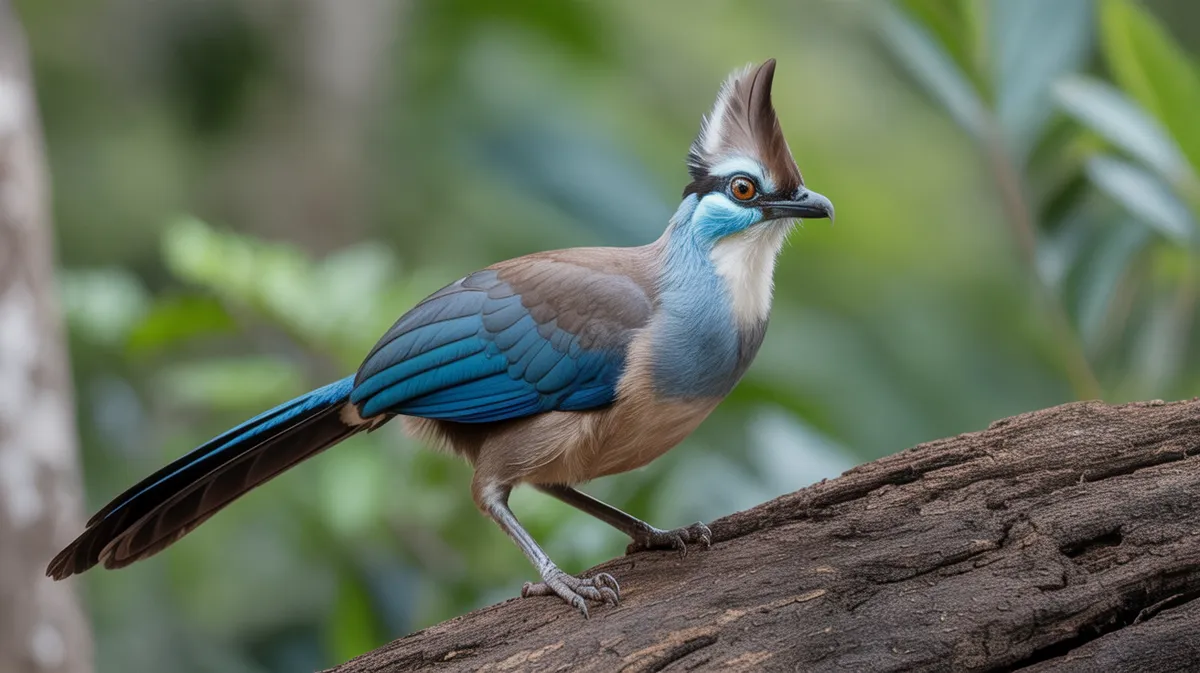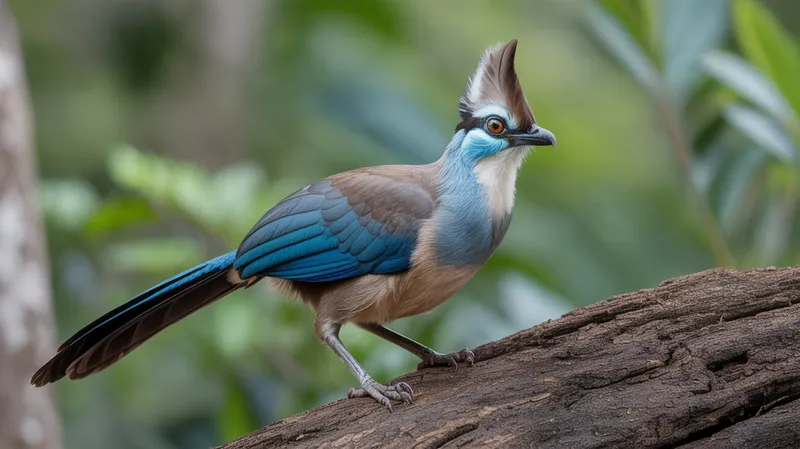
Crested Coua
Coua cristata

Meet the Crested Coua
The Crested Coua is a striking bird native to Madagascar, known for its prominent blue facial skin and elegant crest of elongated feathers atop its head. Its plumage is mostly pale grey to bluish-grey, with a lighter belly and a distinctive greenish back. This arboreal bird is often seen moving slowly and quietly through the forest canopy in search of food. Crested Couas are adept at blending in with foliage, making them elusive despite their bright facial markings. Their unique calls and social behavior play an important role in the soundscape of Madagascar’s forests.
Classification
Bird
Habitat
Dry deciduous forest
Diet
Omnivore
Lifespan
8-12 years
Conservation
Least Concern
Weight
110-140 g
📖Fascinating Facts
Elegant Crest
The Crested Coua sports a striking feathered crest on its head, which it can raise or lower depending on its mood or activity.
Tree-Dwelling Lifestyle
This species spends most of its time in the upper levels of the forest, foraging for insects, fruit, and small invertebrates.
Blue Facial Skin
The bird's bare blue skin around the eye is a distinctive feature, making it easily recognizable among forest birds.
📋Detailed Description
The Crested Coua (Coua cristata) is a medium-sized, arboreal bird endemic to Madagascar, measuring approximately 40–45 cm (16–18 in) in length and weighing between 120–160 grams. Its most distinguishing features include a prominent, wispy grey crest atop the head, and vivid turquoise-blue bare skin patches encircling the eyes, which contrast sharply with its otherwise subtle plumage. The upperparts are a soft greenish-grey, blending into a rufous (reddish-brown) breast and a white or pale grey abdomen. The long tail is graduated, with central feathers being longer and tipped with white. The bill is short, slightly decurved, and blackish, adapted for a varied diet. The feet are zygodactylous (two toes forward, two backward), facilitating agile movement along branches. Crested Couas are primarily canopy dwellers, rarely descending to the ground, and are known for their slow, deliberate movements as they forage. Their calls are varied and include a series of descending whistles and soft coos, contributing to the acoustic environment of Madagascar’s forests. Despite their striking appearance, their cryptic coloration and secretive habits make them challenging to spot in dense foliage. They are generally solitary or found in pairs, but may join mixed-species foraging flocks. The species plays a significant ecological role as both a seed disperser and an insect predator within its native dry deciduous and coastal forests.
💡 Did you know?
The Crested Coua is endemic to Madagascar and cannot be found anywhere else in the world.
🔬Research & Sources
Wikipedia Summary
The crested coua is a common medium-sized bird member of the cuckoo family, Cuculidae. It is endemic to Madagascar, mainly found in the coastal regions of the island. The crested coua is a weak flyer, so it will often be observed hopping from branch to branch in high canopies. It is distinguished mainly by its greenish-grey back, its prominent grey head crest, rufous-coloured breast, white abdomen and bright turquoise and blue patches of bare skin around the eyes.
Last Modified: 5/23/2025
🎭Behavior & Social Structure
Crested Couas are diurnal and spend most of their time in the mid to upper canopy, moving with deliberate hops and short glides between branches. They are omnivorous, feeding on a diverse diet that includes insects (such as caterpillars, beetles, and grasshoppers), small invertebrates, fruits, berries, and occasionally seeds. Foraging is typically solitary or in pairs, though they may associate with other couas or join mixed-species flocks, especially during the non-breeding season. They use their strong, zygodactylous feet to cling to branches while probing leaves and bark for prey. Vocal communication is important for territory maintenance and mate attraction; their calls are distinctive and can be heard over long distances. Crested Couas exhibit a degree of site fidelity, often returning to the same foraging territories. They are generally non-migratory, with daily routines centered around foraging in the morning and late afternoon, and resting or preening during the hottest part of the day.
👶Reproduction & Life Cycle
Breeding occurs primarily during the rainy season, which varies regionally but generally spans from October to March. The species is monogamous, with pairs forming stable bonds during the breeding season. Courtship involves mutual preening and vocal duets. Nests are constructed by both sexes and are shallow, loosely woven platforms of twigs and leaves, typically placed 2–10 meters above ground in dense foliage. The female lays 2–3 eggs, which are white and unmarked. Both parents share incubation duties, which last approximately 15–17 days. After hatching, both adults feed the chicks a diet rich in insects and fruit. The nestlings are altricial (born helpless and blind) and fledge after about 18–21 days. Unlike many other cuckoos, couas are not brood parasites; they raise their own young. Parental care continues for several weeks post-fledging, with juveniles remaining near the nest site while learning to forage.
🛡️Adaptations & Survival
The Crested Coua exhibits several adaptations for its arboreal lifestyle. Its zygodactylous feet provide a strong grip for maneuvering along branches. The cryptic greenish-grey and rufous plumage offers camouflage against the dappled light of the forest canopy, while the bare blue skin around the eyes may serve as a visual signal in dense vegetation. The species’ weak flight is compensated by agility and strong legs, allowing efficient movement through the canopy. Its omnivorous diet and flexible foraging behavior enable it to exploit a wide range of food resources, an advantage in Madagascar’s highly seasonal forests. The vocal repertoire is well-adapted for long-distance communication in dense habitats. Unlike many cuckoos, the absence of brood parasitism in couas is a derived trait, reflecting an evolutionary shift toward parental care within the genus.
🎨Cultural Significance
The Crested Coua does not have a prominent role in Malagasy folklore or traditional culture, unlike some other endemic birds. However, its striking appearance and unique calls make it a favorite among birdwatchers and ecotourists. The species is sometimes featured in local environmental education programs as a symbol of Madagascar’s unique biodiversity. There are no known traditional uses or symbolic associations, but its presence in community-managed forests can help promote conservation awareness.
🔬Recent Research & Discoveries
Recent research on the Crested Coua has focused on its role in seed dispersal and its adaptability to fragmented landscapes. Studies have shown that couas contribute to forest regeneration by consuming and dispersing seeds of native fruiting plants. Ongoing genetic studies are investigating population structure and gene flow across fragmented habitats, providing insights into the species’ resilience to habitat loss. Acoustic monitoring is being used to assess population densities and habitat use. The Crested Coua is also of interest in studies of cuckoo evolution, as its non-parasitic breeding strategy contrasts with the brood parasitism seen in many Old World cuckoos. Long-term ecological monitoring in Madagascar’s protected areas continues to provide valuable data on the species’ status and ecological requirements.
🎥Wildlife Videos

The Enigmatic Blue Coua: Madagascar's Hidden Jewel
Dive into the heart of Madagascar with "The Enigmatic Blue Coua: Madagascar's Hidden Jewel," a captivating documentary that ...
The Animal Central

25 Common Birds Of Madagascar
25 Common Birds Of Madagascar Madagascar is known for its incredible biodiversity, including a wide variety of unique bird ...
ZooLogix

Birds of Madagascar
00:00 Black Kite 00:14 Crested drongo 00:46 Madagascar magpie-robin 01:10 Madagaskar Scops-Owl 01:27 Malagasy Bulbul ...
Marek Jackowski Photography

The Ornate Hawk-eagle— Rufous The Great Frigatebird—crested coua#tiktok #beautiful #love #birds
Lapy Media

Birds of Madagascar
A month-long trip to Madagascar in October 2022 to the Masoala peninsula, Andasibe, Ranomafana, Ifaty and Kirindy. All five ...
Brett Hartl's Wildlife Videos

10 Facts About The Grey Crowned Crested Crane
10 Facts About The Grey Crowned Crested Crane The Crested Crane (a subspecies of the east African Grey-crowned Crane) is a ...
Discover Africa - Latest Sightings
🌍Habitat Information
The Crested Coua typically inhabits Dry deciduous forest environments. Crested Couas have adapted to their environments with specialized features and behaviors.
Primary Habitat:
Dry deciduous forest
More detailed habitat information will be available soon.
🛡️Conservation Status
The Crested Coua is currently classified as Least Concern. Conservation efforts are crucial for preserving this species for future generations.
Common Threats:
- 🏠Habitat loss and fragmentation
- 🌡️Climate change impacts
- 🎯Hunting and poaching
- 🏭Human-wildlife conflict
⚠️Threats & Conservation Challenges
Currently listed as Least Concern by the IUCN, the Crested Coua remains relatively common across its range. However, ongoing habitat loss due to deforestation, slash-and-burn agriculture, and charcoal production poses significant long-term threats. Fragmentation of dry deciduous forests, particularly in western and coastal Madagascar, may impact local populations by reducing available nesting and foraging sites. The species is adaptable and persists in secondary growth and degraded habitats, but continued habitat degradation could lead to declines. There is little evidence of direct hunting or trapping pressure. Climate change, with its potential to alter rainfall patterns and forest structure, represents an emerging challenge. Population trends are currently stable, but continued monitoring is recommended.
🔬Scientific Classification
Scientific Name
Coua cristata
Classification Hierarchy
🔍 About Taxonomic Classification
Taxonomic classification is a hierarchical system used by scientists to classify and organize living organisms based on shared characteristics and evolutionary relationships.
The system moves from broad categories (Kingdom) to increasingly specific ones, with each animal's scientific name typically consisting of its Genus and species.
📝Community Notes
Share your observations and insights about the Crested Coua with our community of wildlife enthusiasts.
Join Our Community
Sign in to share your observations and connect with fellow wildlife enthusiasts.
Sign In to ContributeNo community notes yet
Be the first to share your observations about the Crested Coua!
Explore Crested Coua
Select a tab above to learn more about this amazing animal.
📸Photo Gallery
No photos available for this animal yet.
🌟Discover More Wildlife
Continue your journey of discovery with more fascinating animals from our database
